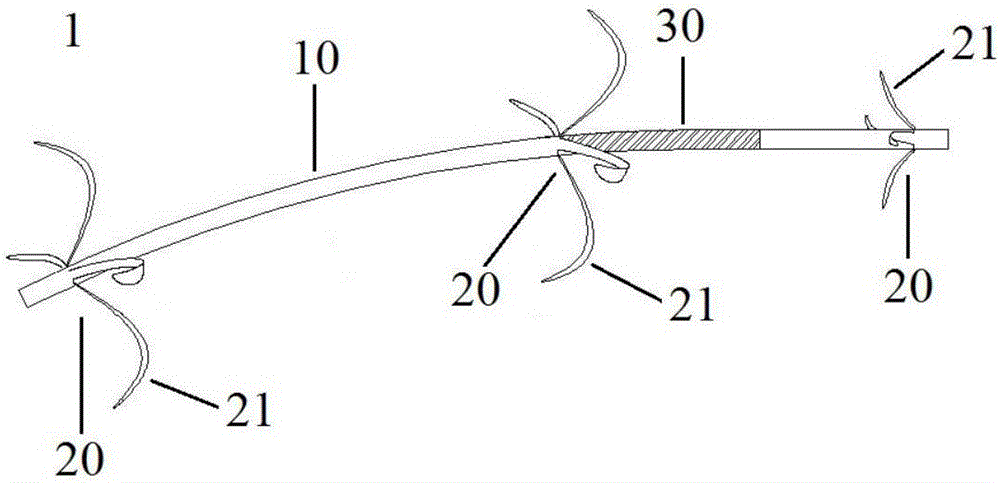Radioactive lumen stent
A radioactive and radionuclide technology, which is applied in the field of radioactive lumen stents, can solve the problems of reducing the flexibility of the stent, occupying the cavity space for implantation, and reducing the flexibility of the stent, and achieves easy preparation or realization and maintenance of drainage effect. , to maintain the effect of treatment
- Summary
- Abstract
- Description
- Claims
- Application Information
AI Technical Summary
Problems solved by technology
Method used
Image
Examples
Embodiment 1
[0066] Such as Figure 1-2 Shown: a radioactive luminal stent 1, including a tube body 10, branch-shaped support wings 20, and a radiation core 31 sealed in the tube body 10, the radiation core 31 being silver foil loaded with radionuclides. The inner wall of the tube body 10 is smooth, and the outer wall of the tube body 10 is smooth except for the branch-shaped supporting wings 20 and grooves.
[0067] There is an annular groove on the outside of the pipe body 10, and the middle part of the groove is wrapped with 125 The silver foil of I, the silver foil wraps the casing and fills the whole groove. The surface of the casing after wrapping the groove is smooth and equal to the outer surface of the pipe body 10 to form a smooth surface.
[0068] The two ends of the pipe body 10 and near the loaded 125 There are branch-shaped support flanks 20 on one side of the near-end of the radiation region produced by the silver foil of I, and each branch-shaped support flank 20 structur...
Embodiment 2
[0075] The implementation mode of embodiment two is the same as that of embodiment one, and the differences are as follows: image 3 As shown: there is an annular groove on the outside of the tube body 10, the middle part of the groove is wrapped with silver foil carrying radionuclides, the other part of the groove is wrapped with a film of equal thickness to the silver foil, and the silver foil and the film are wrapped outside the casing and fill the entire cavity. groove.
Embodiment 3
[0077] The implementation mode of the third embodiment is the same as that of the first embodiment, the differences are as follows Figure 4 As shown: both ends of the tube body 10 and the proximal end of the radioactive region 30 produced by the silver foil loaded with radionuclides have branch-shaped support wings.
PUM
 Login to View More
Login to View More Abstract
Description
Claims
Application Information
 Login to View More
Login to View More - R&D
- Intellectual Property
- Life Sciences
- Materials
- Tech Scout
- Unparalleled Data Quality
- Higher Quality Content
- 60% Fewer Hallucinations
Browse by: Latest US Patents, China's latest patents, Technical Efficacy Thesaurus, Application Domain, Technology Topic, Popular Technical Reports.
© 2025 PatSnap. All rights reserved.Legal|Privacy policy|Modern Slavery Act Transparency Statement|Sitemap|About US| Contact US: help@patsnap.com



